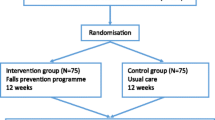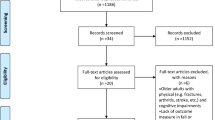Abstract
Exercise programmes are effective in reducing falls but few older people consider doing an exercise programme for falls prevention. This paper examines older people’s perceptions and experiences of falls, physiotherapy and exercise. Individual interviews were conducted with Australian-born and Italian-born older persons who had ≥1 fall in the past 12 months and completed a community-based physiotherapy programme. Although preventing further falls was considered important, participants were unsure whether falls were preventable. Few described evidence-based approaches such as exercise or medication reviews as strategies to prevent falls. Most participants thought that physiotherapy and exercise were beneficial in improving physical function. A clear explanation on the role of exercise for falls prevention, that many falls are preventable, and understanding of personal motivating and de-motivating factors for exercise for falls prevention are important for clinicians to consider in engaging this group of older people.
Similar content being viewed by others
References
Australian Bureau of Statistics. (2005). 2005 year book Australia (cat. no. 1301.0). Canberra: Commonwealth of Australia.
Australian Bureau of Statistics. (2012). Reflecting a nation: Stories from the 2011 census, 2012–2013 (cat. no. 2071.0). Canberra: Commonwealth of Australia.
Australian Government. (2010). Don’t fall for it, falls can be prevented – A guide to preventing falls for older people. Canberra: Commonwealth of Australia.
Barnett, A., Smith, B., Lord, S. R., Williams, M., & Baumand, A. (2003). Community-based group exercise improves balance and reduces falls in at-risk older people: a randomised controlled trial. Age and Ageing, 32(4), 407–414. doi:10.1093/ageing/32.4.407.
Braun, V., & Clarke, V. (2006). Using thematic analysis in psychology. Qualitative Research in Psychology, 3, 77–101.
Carpenter, C. (2013). Phenomenology and rehabilitation research. In P. Liamputtong (ed.), Research methods in health: Foundations for evidence-based practice, 2nd edition (pp. 115–131). Melbourne: Oxford University Press.
Carpenter, C., & Suto, M. (2008). Qualitative research for occupational and physical therapists: A practical guide. Oxford: Blackwell Publishing.
Charmaz, K. (1991). Good days, bad days: The self in chronic illness and time. New Brunswick: Rutgers University Press.
Collerton, J., Kingston, A., Bond, J., Davies, K., Eccles, M. P., Jagger, C., et al. (2012). The personal and health service impact of falls in 85 year olds: cross-sectional findings from the newcastle 85+ cohort study. PLoS ONE, 7(3), e33–e78. doi:10.1371/journal.pone.0033078.
Creswell, J. W. (2012). Qualitative inquiry and research design: Choosing among five approaches (3rd ed.). Thousand Oaks: Sage.
Day, L., Fildes, B., Gordon, I., Fitzharris, M., Flamer, H., & Lord, S. (2002). Randomised factorial trial of falls prevention among older people living in their own homes. British Medical Journal, 325(7356), 128–133. doi:10.1136/bmj.325.7356.128.
Fryer, C., Mackintosh, S., Batchelor, F., Hill, K., & Said, C. (2012). The effect of limited english proficiency on falls risk and falls prevention after stroke. Age and Ageing, 41(1), 104–107. doi:10.1093/ageing/afr127.
Gillespie, L. D., Robertson, M. C., Gillespie, W. J., Sherrington, C., Gates, S., Clemson, L. M., et al. (2012). Interventions for preventing falls in older people living in the community. Cochrane Database Systematic Review, 2012(9), CD007146. doi:10.1002/14651858.CD007146.pub3.
Hill, A.-M., Hoffmann, T., Beer, C., McPhail, S., Hill, K. D., Oliver, D., et al. (2011). Falls after discharge from hospital: is there a gap between older peoples’ knowledge about falls prevention strategies and the research evidence? The Gerontologist, 51(5), 653–662.
Howe, T. E., Rochester, L., Neil, F., Skelton, D. A., & Ballinger, C. (2011). Exercise for improving balance in older people. [Cochrane Review]. Cochrane Database of Systematic Reviews, 2011(11), CD004963. doi:10.1002/14651858.CD004963.pub2.
Hunt, M. (2007). Taking culture seriously: considerations for physiotherapists. Physiotherapy, 93(3), 229–232.
Katon, W., & Kleinman, A. (1981). Doctor-patient negotiation and other social science strategies in patient care. In L. Eisenberg & A. Kleinman (Eds.), The relevance of social science for medicine (pp. 253–279). Dordrecht: D. Reidel Publishing Company.
Kleinman, A. (1980). Patients and healers in the context of culture: An exploration of the borderland between anthropology, medicine, and psychiatry. Berkeley: University of California Press.
Liamputtong, P. (2013). Qualitative research methods, 4th edition. Melbourne: Oxford University Press.
Lin, M.-R., Wolf, S. L., Hwang, H.-F., Gong, S.-Y., & Chen, C.-Y. (2007). A randomized, controlled trial of fall prevention programs and quality of life in older fallers. Journal of the American Geriatrics Society, 55(4), 499–506.
Lord, S. R., Sherrington, C., Menz, H. B., & Close, J. C. (2007). Falls in older people: Risk factors and strategies for prevention (2nd ed.). Cambridge: Cambridge University Press.
Lord, S. R., Ward, J. A., Williams, P., & Anstey, K. J. (1993). An epidemiological study of falls in older community-dwelling women: The Randwick falls and fractures study. Australian Journal of Public Health, 17(3), 240–245.
Moreland, J. D., Richardson, J. A., Goldsmith, C. H., & Clase, C. M. (2004). Muscle weakness and falls in older adults: a systematic review and meta-analysis. Journal of the American Geriatrics Society, 52(7), 1121–1129.
Nitz, J. C., & Choy, N. L. (2004). The efficacy of a specific balance-strategy training programme for preventing falls among older people: A pilot randomised controlled trial. Age and Ageing, 33(1), 52–58. doi:10.1093/ageing/afh029.
Padgett, D. K. (2012). Qualitative and mixed methods in public health. Thousand Oaks: Sage.
Partnership, N. P. H. (2004). The national injury prevention and safety promotion plan: 2004–2014. Canberra: NPHP.
Robertson, M. C., Campbell, A. J., Gardner, M. M., & Devlin, N. (2002). Preventing injuries in older people by preventing falls: a meta-analysis of individual-level data. Journal of the American Geriatrics Society, 50(5), 905–911. doi:10.1046/j.1532-5415.2002.50218.x.
Rosenstock, I. M. (1974). Historical origins of the health belief model. In M. H. Becker (Ed.), The health belief model and personal health behavior (pp. 1–8). New Jersey: Charles B. Slack.
Russell, M. A., Hill, K. D., Blackberry, I., Day, L. L., & Dharmage, S. C. (2006). Falls risk and functional decline in older fallers discharged directly from emergency departments. The Journals of Gerontology, 61A(10), 1090–1095.
Serry, T., & Liamputtong, P. (2013). The in-depth interviewing method in health. In P. Liamputtong (ed.), Research methods in health: foundations for evidence-based practice, 2nd edition (pp. 39-53). Melbourne: Oxford University Press
Sherrington, C., Tiedemann, A., Fairhall, N., Close, J. C., & Lord, S. R. (2011). Exercise to prevent falls in older adults: an updated meta-analysis and best practice recommendations. New South Wales Public Health Bulletin, 22(3–4), 78–83. doi:10.1071/nb10056.
Snodgrass, S. J., Rivett, D. A., & Mackenzie, L. A. (2005). Perceptions of older people about falls injury prevention and physical activity. Australasian Journal on Ageing, 24(2), 114–118.
Tobin, G. A., & Begley, C. M. (2004). Methodological rigour within a qualitative framework. Journal of Advanced Nursing, 48(4), 388–396.
World Health Organization. (2007). WHO global report on falls prevention in older age. Geneva: World Health Organization.
Yang, X. J., Haralambous, B., Angus, J., & Hill, K. (2008). Older chinese australians’ understanding of falls and falls prevention: exploring their needs for information. Australian Journal of Primary Health, 14(1), 36–42.
Yardley, L., Bishop, F. L., Beyer, N., Hauer, K., Kempen, G. I. J. M., Piot-Ziegler, C., et al. (2006a). Older people’s views of falls-prevention interventions in six European countries. The Gerontologist, 46(5), 650–660.
Yardley, L., Donovan-Hall, M., Francis, K., & Todd, C. (2006b). Older people’s views of advice about falls prevention: a qualitative study. Health Education Research, 21(4), 508–517. doi:10.1093/her/cyh077.
Yardley, L., Kirby, S., Ben-Shlomo, Y., Gilbert, R., Whitehead, S., & Todd, C. (2008). How likely are older people to take up different falls prevention activities? Preventive Medicine, 47(5), 554–558.
Acknowledgments
We thank the participants of this study. We are grateful for their kindness and willingness to share their experiences and thoughts on falls, falls prevention and exercise.
Conflict of Interest
The authors declare that they have no conflict of interest.
Author information
Authors and Affiliations
Corresponding author
Rights and permissions
About this article
Cite this article
Lam, J., Liamputtong, P. & Hill, K. Falls, Falls Prevention and the Role of Physiotherapy and Exercise: Perceptions and Interpretations of Italian-Born and Australian-Born Older Persons Living in Australia. J Cross Cult Gerontol 30, 233–249 (2015). https://doi.org/10.1007/s10823-015-9263-z
Published:
Issue Date:
DOI: https://doi.org/10.1007/s10823-015-9263-z




